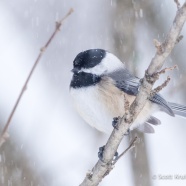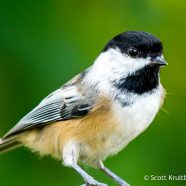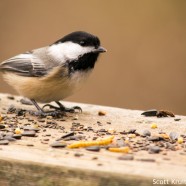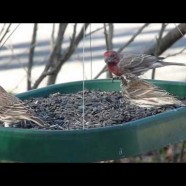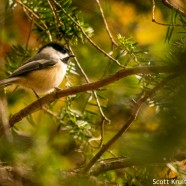Black-capped Chickadee
This may be the last look at a seasonal Sunday bird with snow this winter as it is now meteorological spring! Now that we have crossed into March, cavity-nesting birds like this Black-capped Chickadee (Poecile atricapillus) will be looking for nesting sites. If you enjoy hosting wild birds by providing nest boxes, now is the time to get them ready. Have you ever put out dog fur for birds to use as nesting material? Chickadees, and other small songbirds that use nest boxes and cavities like the Tufted Titmouse, will take fur that you put out in say, an empty suet cage, and use it to line...
Read MoreBlack-capped Chickadee
The Black-capped Chickadee (Poecile atricapillus) is as familiar a backyard resident as can be, but did you know these birds migrate, too? Well, some of them anyway, in a particular way. Young birds move south and irrupt during certain years based on the reproductive success of the summer and the local conditions. The best way to see this is finding a number of them in migratory hotspots in the autumn. If you are at an area such as a beach along the shore of Lake Erie where you typically find zero and suddenly see a flock of six or eight, there you go. I have seen up to 18 in a little flock...
Read MoreBlack-capped Chickadee Feeding
This Black-capped Chickadee (Poecile atricapillus) appeared to be a very indecisive feeder, not knowing what it wanted to eat and trying out some of the selections before tossing some back. I suppose that is the sort of thing you can do when you have piles of food strewn about you. Natural food sources are slowly being drawn down as we near the winter solstice. If you feed the birds you will likely be seeing more activity and action, even from the picky among them. Scott Kruitbosch Conservation & Outreach Coordinator
Read MorePurple Finch vs House Finch comparison with feeder birds
Here we have a female Purple Finch (Haemorhous purpureus) feeding throughout the video along with a female House Finch (Haemorhous mexicanus) and a male House Finch later on. A Tufted Titmouse (Baeolophus bicolor) and Black-capped Chickadee (Poecile atricapillus) also make an appearance among the common feeder birds visiting this tray of sunflower seeds. Note that the female Purple Finch is larger and bulkier than her House Finch counterpart. She has more boldly defined colors in all regards with additional heavier and stronger facial and head markings. Take a few watches to get a feel for...
Read MoreBlack-capped Chickadee (Poecile atricapillus) irruption
There have been Black-capped Chickadees (Poecile atricapillus) moving south in very subtle ways for a couple of months now. If you watch migratory hotspots you can sometimes detect their irruption years, especially if that location is not a particularly friendly habitat for the species. I have seen flocks of 10-20 birds tightly packed together and feeding on the move, possibly heading for a feeding station like yours. I always wonder what particular triggers end up notifying a widespread and highly adaptive bird like this one that they should nonetheless change their quarters for the autumn...
Read More



